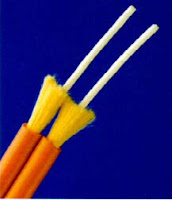Introduction
Optical fiber is an excellent transmition medium used by systems that require a high bandwidth, like the telephony systems, videoconference, local networks (LANs), etc.
Optical fiber is an excellent transmition medium used by systems that require a high bandwidth, like the telephony systems, videoconference, local networks (LANs), etc.
There are two main advantages on
optical fibers over metallic cables. Optical fiber is totally imune to
electromagnetic interference, which means that data isn't corrupted
during their transmition. The second main advantage is that optical
fiber doesn't conduct electrical current, thus no electricity-related
issue is found by using optical fibers, like electrical potential
difference between devices or problems with lightnings.
As the name implies, optical fibers use light to transmit data. At one end of the cable, a LED (Light Emitting Diode) or a semiconductor laser is used as the light source. LEDs can transmit data up to 300 Mbps and is used on short-distance fibers, while with laser the transfer rate can easily reach the Gbps range and is used in long-distance fibers.
The light used in optical fibers is near the infrared range, so it is invisible to the human eye. Actually optical fibers can use light from different wavelenghts, as you can in the table below. Recently ITU classified the wavelenghts that can be used in optical fibers into "bands". So an optical fiber operating on the O band means that the wavelenght of the light used in the cable is between 1260 and 1360 nm.
As the name implies, optical fibers use light to transmit data. At one end of the cable, a LED (Light Emitting Diode) or a semiconductor laser is used as the light source. LEDs can transmit data up to 300 Mbps and is used on short-distance fibers, while with laser the transfer rate can easily reach the Gbps range and is used in long-distance fibers.
The light used in optical fibers is near the infrared range, so it is invisible to the human eye. Actually optical fibers can use light from different wavelenghts, as you can in the table below. Recently ITU classified the wavelenghts that can be used in optical fibers into "bands". So an optical fiber operating on the O band means that the wavelenght of the light used in the cable is between 1260 and 1360 nm.
Band
|
Descriptor
|
Range (nm)
|
O band
|
Original
|
1260 to 1360
|
E band
|
Extended
|
1360 to 1460
|
S band
|
Short wavelength
|
1460 to 1530
|
C band
|
Conventional
|
1530 to 1565
|
L band
|
Long wavelength
|
1565 to 1625
|
U band
|
Ultralong wavelength
|
1625 to 1675
|
Anatomy of Optical Fibers
The fundamental principle behind optical fibers is a physic phenomena called total internal reflection. In order to have total internal reflection, light has to get out from a more refringent (refractive) medium to a less refrigent one and the angle of incidence must be equal or greater than the limit angle (also known as Brewster angle).
The fundamental principle behind optical fibers is a physic phenomena called total internal reflection. In order to have total internal reflection, light has to get out from a more refringent (refractive) medium to a less refrigent one and the angle of incidence must be equal or greater than the limit angle (also known as Brewster angle).
Figure 1: Example of an optical fiber.
Optical fibers are basically made
of dielectric (insulating) materials that, as we already mentioned,
allow complete imunity to electromagnetic interference, having two
areas, a center region called core, where the light pass through, and an
external region called cladding which covers the core. The refracting
index of the material used on the core is higher than the refracting
index from the material used on the cladding.
In Figure 2, you can see the anatomy of an optical fiber.
In Figure 2, you can see the anatomy of an optical fiber.
Figure 2: Anatomy of an optical fiber.
Here is the description of each part of the optical fiber:
* Core: The core is a thin filament made of glass or plastic, measured in micra (1 μm = 0,000001m), where the light pass through. The larger the diameter of the core, the more light it can conduct.
* Cladding: Layer that revests the core. Since it has a refraction index lower than the core, it prevents the light from being refracted, hence allowing the light to reach the reception device.
* Plastic buffer: Plastic layer that revest the skin, protecting the optical fiber from mechanical shocks and excess of bending.
* Mechanic resistence fibers: Fibers that help to protect the core against impacts and excessive tensions during their installation. They are usually made of a material called kevlar, the same used on bullet-proof vests.
* Outer jacket: Is the jacket that covers the optical fiber.
Types:
There are two types of optical fibers: multimode and single-mode (or monomode). These types define how light travels inside the fiber core.
* Multimode: On multimode fibers the core diameter is greater than the core diameter of single-mode fibers, making the light to have several propagation modes, i.e. the light goes through the fiber core using several paths and not using a single path, like in single-mode fibers. Multimode fibers have a core diameter 50 to 100 microns (typical commercial values are 50, 62.5 and 100 microns) and a cladding diameter of 125 microns. Multimode fibers can be classified into graded-index and step-index, depeding on the refraction index between the core and the cladding - on graded-index there is a gradual change between the core and the cladding, while on step-index this change is abrupt, hence the name. Step-index fibers can transmit data up to 50 Mbps, while grade-index fibers can transmit data up to 1 Gbps. Multi-Mode fibers are also known as MMF and they are used by short-distance fibers.
* Single-mode: single-mode fibers are used in long-distance cables, but they require connectors with better precision and expensive devices. On this kind of fiber the light has only one way of travelling inside the fiber core, hence its name. The core diameter is between 7 and 10 microns and its cladding diameter is around 125 microns, so both multi-mode and mono-mode cables have the same diameter, what makes the difference is the diameter of the core. There are three types of single-mode fibers: non dispersion-shifted fiber (NDSF), dispersion-shifted fiber (DSF) and non zero-dispersion-shifted fibers (NZ-DSF).
ITU released a series of standards in order to classify the properties of multimode and single-mode fibers:
* ITU G.651: Graded-index multimode fibers with 50-micron core diameter and 125-micron cladding diameter.
* ITU G.652: Non dispersion-shifted fiber (NDSF) single-mode fibers using 1,130-nm wavelenght supporting the following distances and transfer rates: 1,000 km (621 miles) at 2.5 Gbps, 60 km (37 miles) at 10 Gbps and 3 km (1.86 miles) at 40 Gbps.
* ITU G.653: Dispersion-shifted (DSF) single-mode fibers.
* ITU G.655: Non-zero dispersion-shifted (NZ-DSF) single-mode fibers. It supports the following distances and transfer rates: 6,000 km (3,730 miles) at 2.5 Gbps, 400 km (250 miles) at 10 Gbps and 25 km (15.5 miles) at 40 Gbps.
Important: Optical fibers trasmit light in a wave lenght invisible to the human eye. So, we can never look directly to the end of an optical fiber while it is connected to a system, because we can go blind looking at it.
* Core: The core is a thin filament made of glass or plastic, measured in micra (1 μm = 0,000001m), where the light pass through. The larger the diameter of the core, the more light it can conduct.
* Cladding: Layer that revests the core. Since it has a refraction index lower than the core, it prevents the light from being refracted, hence allowing the light to reach the reception device.
* Plastic buffer: Plastic layer that revest the skin, protecting the optical fiber from mechanical shocks and excess of bending.
* Mechanic resistence fibers: Fibers that help to protect the core against impacts and excessive tensions during their installation. They are usually made of a material called kevlar, the same used on bullet-proof vests.
* Outer jacket: Is the jacket that covers the optical fiber.
Types:
There are two types of optical fibers: multimode and single-mode (or monomode). These types define how light travels inside the fiber core.
* Multimode: On multimode fibers the core diameter is greater than the core diameter of single-mode fibers, making the light to have several propagation modes, i.e. the light goes through the fiber core using several paths and not using a single path, like in single-mode fibers. Multimode fibers have a core diameter 50 to 100 microns (typical commercial values are 50, 62.5 and 100 microns) and a cladding diameter of 125 microns. Multimode fibers can be classified into graded-index and step-index, depeding on the refraction index between the core and the cladding - on graded-index there is a gradual change between the core and the cladding, while on step-index this change is abrupt, hence the name. Step-index fibers can transmit data up to 50 Mbps, while grade-index fibers can transmit data up to 1 Gbps. Multi-Mode fibers are also known as MMF and they are used by short-distance fibers.
* Single-mode: single-mode fibers are used in long-distance cables, but they require connectors with better precision and expensive devices. On this kind of fiber the light has only one way of travelling inside the fiber core, hence its name. The core diameter is between 7 and 10 microns and its cladding diameter is around 125 microns, so both multi-mode and mono-mode cables have the same diameter, what makes the difference is the diameter of the core. There are three types of single-mode fibers: non dispersion-shifted fiber (NDSF), dispersion-shifted fiber (DSF) and non zero-dispersion-shifted fibers (NZ-DSF).
ITU released a series of standards in order to classify the properties of multimode and single-mode fibers:
* ITU G.651: Graded-index multimode fibers with 50-micron core diameter and 125-micron cladding diameter.
* ITU G.652: Non dispersion-shifted fiber (NDSF) single-mode fibers using 1,130-nm wavelenght supporting the following distances and transfer rates: 1,000 km (621 miles) at 2.5 Gbps, 60 km (37 miles) at 10 Gbps and 3 km (1.86 miles) at 40 Gbps.
* ITU G.653: Dispersion-shifted (DSF) single-mode fibers.
* ITU G.655: Non-zero dispersion-shifted (NZ-DSF) single-mode fibers. It supports the following distances and transfer rates: 6,000 km (3,730 miles) at 2.5 Gbps, 400 km (250 miles) at 10 Gbps and 25 km (15.5 miles) at 40 Gbps.
Important: Optical fibers trasmit light in a wave lenght invisible to the human eye. So, we can never look directly to the end of an optical fiber while it is connected to a system, because we can go blind looking at it.
















Post a Comment
Note: only a member of this blog may post a comment.